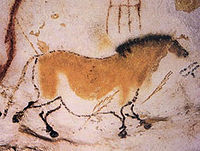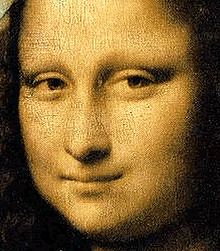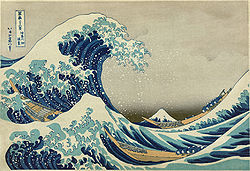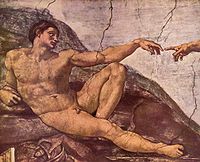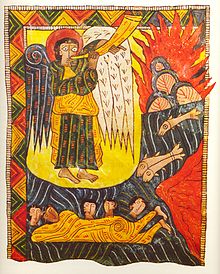- Art
-
This article is about the general concept of Art. For the categories of different artistic disciplines, see The arts. For the arts that are visual in nature, see Visual arts. For people named Art, see Arthur (disambiguation). For other uses, see Art (disambiguation).
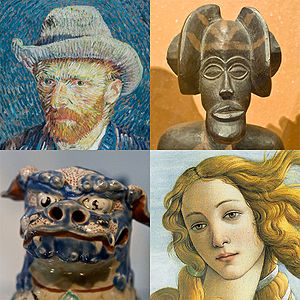 Clockwise from upper left: A self-portrait from Vincent van Gogh, an African Chokwe-statue, detail from the Birth of Venus by Sandro Botticelli and a Japanese Shisa lion
Clockwise from upper left: A self-portrait from Vincent van Gogh, an African Chokwe-statue, detail from the Birth of Venus by Sandro Botticelli and a Japanese Shisa lion
Art is the product or process of deliberately arranging items (often with symbolic significance) in a way that influences and affects one or more of the senses, emotions, and intellect. It encompasses a diverse range of human activities, creations, and modes of expression, including music, literature, film, photography, sculpture, and paintings. The meaning of art is explored in a branch of philosophy known as aesthetics, whereas disciplines such as anthropology, sociology and psychology analyze its relationship with humans and generations.
Traditionally, the term art was used to refer to any skill or mastery. This conception changed during the Romantic period, when art came to be seen as "a special faculty of the human mind to be classified with religion and science".[1] Generally, art is made with the intention of stimulating thoughts and emotions.
Contents
Evaluation
J.S.Bach
Toccata und FugeL.v. Beethoven
Symphonie 5 c-mollR. Wagner
Die WalkürePhilosopher Richard Wollheim distinguishes three approaches to assessing the aesthetic value of art:
- the realist, whereby aesthetic quality is an absolute value independent of any human view
- the objectivist, whereby it is also an absolute value, but is dependent on general human experience
- the relativist position, whereby it is not an absolute value, but depends on, and varies with, the human experience of different humans.[2]
An object may be characterized by the intentions, or lack thereof, of its creator, regardless of its apparent purpose. A cup, which ostensibly can be used as a container, may be considered art if intended solely as an ornament, while a painting may be deemed craft if mass-produced.
The nature of art has been described by Wollheim as "one of the most elusive of the traditional problems of human culture".[3] It has been defined as a vehicle for the expression or communication of emotions and ideas, a means for exploring and appreciating formal elements for their own sake, and as mimesis or representation. Leo Tolstoy identified art as a use of indirect means to communicate from one person to another.[4] Benedetto Croce and R.G. Collingwood advanced the idealist view that art expresses emotions, and that the work of art therefore essentially exists in the mind of the creator.[5][6] The theory of art as form has its roots in the philosophy of Immanuel Kant, and was developed in the early twentieth century by Roger Fry and Clive Bell. Art as mimesis or representation has deep roots in the philosophy of Aristotle.[4] More recently, thinkers influenced by Martin Heidegger have interpreted art as the means by which a community develops for itself a medium for self-expression and interpretation.[7]
Definition
Britannica Online defines art as "the use of skill and imagination in the creation of aesthetic objects, environments, or experiences that can be shared with others." By this definition of the word, artistic works have existed for almost as long as humankind: from early pre-historic art to contemporary art; however, some theories restrict the concept to modern Western societies.[8] The first and broadest sense of art is the one that has remained closest to the older Latin meaning, which roughly translates to "skill" or "craft." A few examples where this meaning proves very broad include artifact, artificial, artifice, medical arts, and military arts. However, there are many other colloquial uses of the word, all with some relation to its etymology.
20th-century Rwandan bottle. Artistic works may serve practical functions, in addition to their decorative value.
The second and more recent sense of the word art is as an abbreviation for creative art or fine art and emerged in the early 17th century.[9] Fine art means that a skill is being used to express the artist's creativity, or to engage the audience's aesthetic sensibilities, or to draw the audience towards consideration of the finer things.
Goethe defined art as an other resp. a second nature, according to his ideal of a style that be founded on the very basic fundaments of insight and on the innermost character of things.[10]
The word art can describe several things: a study of creative skill, a process of using the creative skill, a product of the creative skill, or the audience's experience with the creative skill. The creative arts (art as discipline) are a collection of disciplines (arts) that produce artworks (art as objects) that are compelled by a personal drive (art as activity) and echo or reflect a message, mood, or symbolism for the viewer to interpret (art as experience). Artworks can be defined by purposeful, creative interpretations of limitless concepts or ideas in order to communicate something to another person. They can be explicitly made for this purpose or interpreted on the basis of images or objects. Art is something that stimulates an individual's thoughts, emotions, beliefs, or ideas through the senses. It is also an expression of an idea and it can take many different forms and serve many different purposes. Although the application of scientific knowledge to derive a new scientific theory involves skill and results in the "creation" of something new, this represents science only and is not categorized as art.
Often, if the skill is being used in a common or practical way, people will consider it a craft instead of art. Likewise, if the skill is being used in a commercial or industrial way, it will be considered commercial art instead of fine art. On the other hand, crafts and design are sometimes considered applied art. Some art followers have argued that the difference between fine art and applied art has more to do with value judgments made about the art than any clear definitional difference.[11] However, even fine art often has goals beyond pure creativity and self-expression. The purpose of works of art may be to communicate ideas, such as in politically, spiritually, or philosophically motivated art; to create a sense of beauty (see aesthetics); to explore the nature of perception; for pleasure; or to generate strong emotions. The purpose may also be seemingly nonexistent.
History
Main article: History of artSculptures, cave paintings, rock paintings, and petroglyphs from the Upper Paleolithic dating to roughly 40,000 years ago have been found, but the precise meaning of such art is often disputed because so little is known about the cultures that produced them. The oldest art objects in the world—a series of tiny, drilled snail shells about 75,000 years old—were discovered in a South African cave.[12] Containers that may have been used to hold paints have been found dating as far back as 100,000 years.[13]
Many great traditions in art have a foundation in the art of one of the great ancient civilizations: Ancient Egypt, Mesopotamia, Persia, India, China, Ancient Greece, Rome, as well as Inca, Maya, and Olmec. Each of these centers of early civilization developed a unique and characteristic style in its art. Because of the size and duration of these civilizations, more of their art works have survived and more of their influence has been transmitted to other cultures and later times. Some also have provided the first records of how artists worked. For example, this period of Greek art saw a veneration of the human physical form and the development of equivalent skills to show musculature, poise, beauty, and anatomically correct proportions.
In Byzantine and Medieval art of the Western Middle Ages, much art focused on the expression of Biblical and religious truths, and used styles that showed the higher glory of a heavenly world, such as the use of gold in the background of paintings, or glass in mosaics or windows, which also presented figures in idealized, patterned (flat) forms. Nevertheless a classical realist tradition persisted in small Byzantine works, and realism steadily grew in the art of Catholic Europe.
Renaissance art had a greatly increased emphasis on the realistic depiction of the material world, and the place of humans in it, reflected in the corporeality of the human body, and development of a systematic method of graphical perspective to depict recession in a three-dimensional picture space.
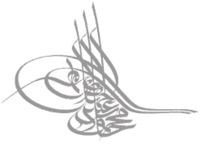 The stylized signature of Sultan Mahmud II of the Ottoman Empire was written in Arabic calligraphy. It reads Mahmud Khan son of Abdulhamid is forever victorious.
The stylized signature of Sultan Mahmud II of the Ottoman Empire was written in Arabic calligraphy. It reads Mahmud Khan son of Abdulhamid is forever victorious.
 The Great Mosque of Kairouan (also called the Mosque of Uqba) is one of the finest, most significant and best preserved artistic and architectural examples of early great mosques; dated in its present state from the 9th century, it is the ancestor and model of all the mosques in the western Islamic lands.[14] The Great Mosque of Kairouan is located in the city of Kairouan in Tunisia.
The Great Mosque of Kairouan (also called the Mosque of Uqba) is one of the finest, most significant and best preserved artistic and architectural examples of early great mosques; dated in its present state from the 9th century, it is the ancestor and model of all the mosques in the western Islamic lands.[14] The Great Mosque of Kairouan is located in the city of Kairouan in Tunisia.
In the east, Islamic art's rejection of iconography led to emphasis on geometric patterns, calligraphy, and architecture. Further east, religion dominated artistic styles and forms too. India and Tibet saw emphasis on painted sculptures and dance, while religious painting borrowed many conventions from sculpture and tended to bright contrasting colors with emphasis on outlines. China saw the flourishing of many art forms: jade carving, bronzework, pottery (including the stunning terracotta army of Emperor Qin), poetry, calligraphy, music, painting, drama, fiction, etc. Chinese styles vary greatly from era to era and each one is traditionally named after the ruling dynasty. So, for example, Tang Dynasty paintings are monochromatic and sparse, emphasizing idealized landscapes, but Ming Dynasty paintings are busy and colorful, and focus on telling stories via setting and composition. Japan names its styles after imperial dynasties too, and also saw much interplay between the styles of calligraphy and painting. Woodblock printing became important in Japan after the 17th century.
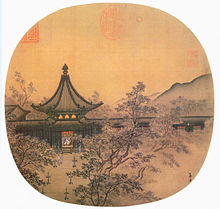 Painting by Song Dynasty artist Ma Lin, circa 1250. 24,8 × 25,2 cm
Painting by Song Dynasty artist Ma Lin, circa 1250. 24,8 × 25,2 cm
The western Age of Enlightenment in the 18th century saw artistic depictions of physical and rational certainties of the clockwork universe, as well as politically revolutionary visions of a post-monarchist world, such as Blake's portrayal of Newton as a divine geometer, or David's propagandistic paintings. This led to Romantic rejections of this in favor of pictures of the emotional side and individuality of humans, exemplified in the novels of Goethe. The late 19th century then saw a host of artistic movements, such as academic art, Symbolism, impressionism and fauvism among others.
The history of twentieth century art is a narrative of endless possibilities and the search for new standards, each being torn down in succession by the next. Thus the parameters of Impressionism, Expressionism, Fauvism, Cubism, Dadaism, Surrealism, etc. cannot be maintained very much beyond the time of their invention. Increasing global interaction during this time saw an equivalent influence of other cultures into Western art, such as Pablo Picasso being influenced by African sculpture. Japanese woodblock prints (which had themselves been influenced by Western Renaissance draftsmanship) had an immense influence on Impressionism and subsequent development. Later, African sculptures were taken up by Picasso and to some extent by Matisse. Similarly, the west has had huge impacts on Eastern art in the 19th and 20th centuries, with originally western ideas like Communism and Post-Modernism exerting a powerful influence on artistic styles.
Modernism, the idealistic search for truth, gave way in the latter half of the 20th century to a realization of its unattainability. Theodor W. Adorno said in 1970, "It is now taken for granted that nothing which concerns art can be taken for granted any more: neither art itself, nor art in relationship to the whole, nor even the right of art to exist."[15] Relativism was accepted as an unavoidable truth, which led to the period of contemporary art and postmodern criticism, where cultures of the world and of history are seen as changing forms, which can be appreciated and drawn from only with irony. Furthermore the separation of cultures is increasingly blurred and some argue it is now more appropriate to think in terms of a global culture, rather than regional cultures.
Characteristics
Art tends to facilitate intuitive rather than rational understanding, and is usually consciously created with this intention.[citation needed] Fine art intentionally serves no other purpose.[dubious ] As a result of this impetus, works of art are elusive, refractive to attempts at classification, because they can be appreciated in more than one way, and are often susceptible to many different interpretations. In the case of Géricault's Raft of the Medusa, special knowledge concerning the shipwreck that the painting depicts is not a prerequisite to appreciating it, but allows the appreciation of Géricault's political intentions in the piece. Even art that superficially depicts a mundane event or object, may invite reflection upon elevated themes.
Traditionally, the highest achievements of art demonstrate a high level of ability or fluency within a medium. This characteristic might be considered a point of contention, since many modern artists (most notably, conceptual artists) do not themselves create the works they conceive, or do not even create the work in a conventional, demonstrative sense. Art has a transformative capacity: it confers particularly appealing or aesthetically satisfying structures or forms upon an original set of unrelated, passive constituents.
Forms, genres, media, and styles
Main article: The artsThe creative arts are often divided into more specific categories, each related to its technique, or medium, such as decorative arts, plastic arts, performing arts, or literature. Unlike scientific fields, art is one of the few subjects that are academically organized according to technique [2]. An artistic medium is the substance or material the artistic work is made from, and may also refer to the technique used. For example, paint is a medium used in painting, and paper is a medium used in drawing.
An art form is the specific shape, or quality an artistic expression takes. The media used often influence the form. For example, the form of a sculpture must exist in space in three dimensions, and respond to gravity. The constraints and limitations of a particular medium are thus called its formal qualities. To give another example, the formal qualities of painting are the canvas texture, color, and brush texture. The formal qualities of video games are non-linearity, interactivity and virtual presence. The form of a particular work of art is determined by the formal qualities of the media, and is not related to the intentions of the artist or the reactions of the audience in any way what so ever.
A genre is a set of conventions and styles within a particular medium. For instance, well recognized genres in film are western, horror and romantic comedy. Genres in music include death metal and trip hop. Genres in painting include still life and pastoral landscape. A particular work of art may bend or combine genres but each genre has a recognizable group of conventions, clichés and tropes. (One note: the word genre has a second older meaning within painting; genre painting was a phrase used in the 17th to 19th centuries to refer specifically to paintings of scenes of everyday life and can still be used in this way.)
The style of an artwork, artist, or movement is the distinctive method and form followed by the respective art. Any loose brushy, dripped or poured abstract painting is called expressionistic. Often a style is linked with a particular historical period, set of ideas, and particular artistic movement. So Jackson Pollock is called an Abstract Expressionist.
Because a particular style may have specific cultural meanings, it is important to be sensitive to differences in technique. Roy Lichtenstein's (1923–1997) paintings are not pointillist, despite his uses of dots, because they are not aligned with the original proponents of Pointillism. Lichtenstein used Ben-Day dots: they are evenly spaced and create flat areas of color. Dots of this type, used in halftone printing, were originally used in comic strips and newspapers to reproduce color. Lichtenstein thus uses the dots as a style to question the "high" art of painting with the "low" art of comics – to comment on class distinctions in culture. Lichtenstein is thus associated with the American Pop art movement (1960s). Pointillism is a technique in late Impressionism (1880s), developed especially by the artist Georges Seurat, that employs dots that are spaced in a way to create variation in color and depth in an attempt to paint images that were closer to the way people really see color. Both artists use dots, but the particular style and technique relate to the artistic movement adopted by each artist.
These are all ways of beginning to define a work of art, to narrow it down. "Imagine you are an art critic whose mission is to compare the meanings you find in a wide range of individual artworks. How would you proceed with your task? One way to begin is to examine the materials each artist selected in making an object, image video, or event. The decision to cast a sculpture in bronze, for instance, inevitably effects its meaning; the work becomes something different from how it might be if it had been cast in gold or plastic or chocolate, even if everything else about the artwork remains the same. Next, you might examine how the materials in each artwork have become an arrangement of shapes, colors, textures, and lines. These, in turn, are organized into various patterns and compositional structures. In your interpretation, you would comment on how salient features of the form contribute to the overall meaning of the finished artwork. [But in the end] the meaning of most artworks... is not exhausted by a discussion of materials, techniques, and form. Most interpretations also include a discussion of the ideas and feelings the artwork engenders."[16]
Skill and craft
See also: Conceptual Art and Artistic SkillArt can connote a sense of trained ability or mastery of a medium. Art can also simply refer to the developed and efficient use of a language to convey meaning with immediacy and or depth. Art is an act of expressing feelings, thoughts, and observations.[17] There is an understanding that is reached with the material as a result of handling it, which facilitates one's thought processes. A common view is that the epithet "art", particular in its elevated sense, requires a certain level of creative expertise by the artist, whether this be a demonstration of technical ability, an originality in stylistic approach, or a combination of these two. Traditionally skill of execution was viewed as a quality inseparable from art and thus necessary for its success; for Leonardo da Vinci, art, neither more nor less than his other endeavors, was a manifestation of skill. Rembrandt's work, now praised for its ephemeral virtues, was most admired by his contemporaries for its virtuosity. At the turn of the 20th century, the adroit performances of John Singer Sargent were alternately admired and viewed with skepticism for their manual fluency, yet at nearly the same time the artist who would become the era's most recognized and peripatetic iconoclast, Pablo Picasso, was completing a traditional academic training at which he excelled.
A common contemporary criticism of some modern art occurs along the lines of objecting to the apparent lack of skill or ability required in the production of the artistic object. In conceptual art, Marcel Duchamp's "Fountain" is among the first examples of pieces wherein the artist used found objects ("ready-made") and exercised no traditionally recognised set of skills. Tracey Emin's My Bed, or Damien Hirst's The Physical Impossibility of Death in the Mind of Someone Living follow this example and also manipulate the mass media. Emin slept (and engaged in other activities) in her bed before placing the result in a gallery as work of art. Hirst came up with the conceptual design for the artwork but has left most of the eventual creation of many works to employed artisans. Hirst's celebrity is founded entirely on his ability to produce shocking concepts. The actual production in many conceptual and contemporary works of art is a matter of assembly of found objects. However there are many modernist and contemporary artists who continue to excel in the skills of drawing and painting and in creating hands-on works of art.
Value judgment
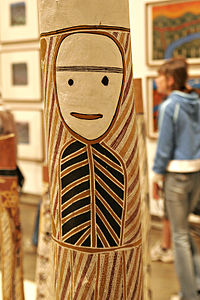 Aboriginal hollow log tombs. National Gallery, Canberra, Australia
Aboriginal hollow log tombs. National Gallery, Canberra, Australia
Somewhat in relation to the above, the word art is also used to apply judgments of value, as in such expressions as "that meal was a work of art" (the cook is an artist), or "the art of deception", (the highly attained level of skill of the deceiver is praised). It is this use of the word as a measure of high quality and high value that gives the term its flavor of subjectivity.
Making judgments of value requires a basis for criticism. At the simplest level, a way to determine whether the impact of the object on the senses meets the criteria to be considered art is whether it is perceived to be attractive or repulsive. Though perception is always colored by experience, and is necessarily subjective, it is commonly understood that what is not somehow aesthetically satisfying cannot be art. However, "good" art is not always or even regularly aesthetically appealing to a majority of viewers. In other words, an artist's prime motivation need not be the pursuit of the aesthetic. Also, art often depicts terrible images made for social, moral, or thought-provoking reasons. For example, Francisco Goya's painting depicting the Spanish shootings of 3rd of May 1808 is a graphic depiction of a firing squad executing several pleading civilians. Yet at the same time, the horrific imagery demonstrates Goya's keen artistic ability in composition and execution and produces fitting social and political outrage. Thus, the debate continues as to what mode of aesthetic satisfaction, if any, is required to define 'art'.
The assumption of new values or the rebellion against accepted notions of what is aesthetically superior need not occur concurrently with a complete abandonment of the pursuit of what is aesthetically appealing. Indeed, the reverse is often true, that the revision of what is popularly conceived of as being aesthetically appealing allows for a re-invigoration of aesthetic sensibility, and a new appreciation for the standards of art itself. Countless schools have proposed their own ways to define quality, yet they all seem to agree in at least one point: once their aesthetic choices are accepted, the value of the work of art is determined by its capacity to transcend the limits of its chosen medium to strike some universal chord by the rarity of the skill of the artist or in its accurate reflection in what is termed the zeitgeist.
Art is often intended to appeal to and connect with human emotion. It can arouse aesthetic or moral feelings, and can be understood as a way of communicating these feelings. Artists express something so that their audience is aroused to some extent, but they do not have to do so consciously. Art may be considered an exploration of the human condition; that is, what it is to be human.[18]
Purpose of art
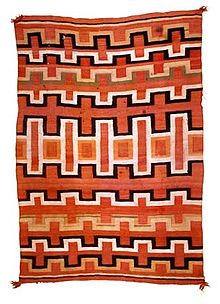 A Navajo rug made circa 1880
A Navajo rug made circa 1880
Art has had a great number of different functions throughout its history, making its purpose difficult to abstract or quantify to any single concept. This does not imply that the purpose of Art is "vague", but that it has had many unique, different reasons for being created. Some of these functions of Art are provided in the following outline. The different purposes of art may be grouped according to those that are non-motivated, and those that are motivated (Levi-Strauss).
Non-motivated functions of art
The non-motivated purposes of art are those that are integral to being human, transcend the individual, or do not fulfill a specific external purpose. Aristotle said, "Imitation, then, is one instinct of our nature." [19] In this sense, Art, as creativity, is something humans must do by their very nature (i.e., no other species creates art), and is therefore beyond utility.
- Basic human instinct for harmony, balance, rhythm. Art at this level is not an action or an object, but an internal appreciation of balance and harmony (beauty), and therefore an aspect of being human beyond utility.
"Imitation, then, is one instinct of our nature. Next, there is the instinct for 'harmony' and rhythm, meters being manifestly sections of rhythm. Persons, therefore, starting with this natural gift developed by degrees their special aptitudes, till their rude improvisations gave birth to Poetry." -Aristotle [20]
- Experience of the mysterious. Art provides a way to experience one's self in relation to the universe. This experience may often come unmotivated, as one appreciates art, music or poetry.
"The most beautiful thing we can experience is the mysterious. It is the source of all true art and science." -Albert Einstein [21]
- Expression of the imagination. Art provide a means to express the imagination in non-grammatic ways that are not tied to the formality of spoken or written language. Unlike words, which come in sequences and each of which have a definite meaning, art provides a range of forms, symbols and ideas with meanings that are maleable.
"Jupiter's eagle [as an example of art] is not, like logical (aesthetic) attributes of an object, the concept of the sublimity and majesty of creation, but rather something else – something that gives the imagination an incentive to spread its flight over a whole host of kindred representations that provoke more thought than admits of expression in a concept determined by words. They furnish an aesthetic idea, which serves the above rational idea as a substitute for logical presentation, but with the proper function, however, of animating the mind by opening out for it a prospect into a field of kindred representations stretching beyond its ken." -Immanuel Kant[22]
- Universal communication. Art allows the individual to express things toward the world as a whole.[according to whom?] Earth artists often create art in remote locations that will never be experienced by another person. The practice of placing a cairn, or pile of stones at the top of a mountain, is an example. (Note: This need not suggest a particular view of God, or religion.) Art created in this way is a form of communication between the individual and the world as a whole.[citation needed]
- Ritualistic and symbolic functions. In many cultures, art is used in rituals, performances and dances as a decoration or symbol. While these often have no specific utilitarian (motivated) purpose, anthropologists know that they often serve a purpose at the level of meaning within a particular culture. This meaning is not furnished by any one individual, but is often the result of many generations of change, and of a cosmological relationship within the culture.
"Most scholars who deal with rock paintings or objects recovered from prehistoric contexts that cannot be explained in utilitarian terms and are thus categorized as decorative, ritual or symbolic, are aware of the trap posed by the term 'art'." -Silva Tomaskova[23]
Motivated functions of art
Motivated purposes of art refer to intentional, conscious actions on the part of the artists or creator. These may be to bring about political change, to comment on an aspect of society, to convey a specific emotion or mood, to address personal psychology, to illustrate another discipline, to (with commercial arts) to sell a product, or simply as a form of communication.
- Communication. Art, at its simplest, is a form of communication. As most forms of communication have an intent or goal directed toward another individual, this is a motivated purpose. Illustrative arts, such as scientific illustration, are a form of art as communication. Maps are another example. However, the content need not be scientific. Emotions, moods and feelings are also communicated through art.
"[Art is a set of] artefacts or images with symbolic meanings as a means of communication." -Steve Mithen[24]
- Art as entertainment. Art may seek to bring about a particular emotion or mood, for the purpose of relaxing or entertaining the viewer. This is often the function of the art industries of Motion Pictures and Video Games.
- The Avante-Garde. Art for political change. One of the defining functions of early twentieth century art has been to use visual images to bring about political change. Art movements that had this goal—Dadaism, Surrealism, Russian Constructivism, and Abstract Expressionism, among others—are collectively referred to as the avante-garde arts.
"By contrast, the realistic attitude, inspired by positivism, from Saint Thomas Aquinas to Anatole France, clearly seems to me to be hostile to any intellectual or moral advancement. I loathe it, for it is made up of mediocrity, hate, and dull conceit. It is this attitude which today gives birth to these ridiculous books, these insulting plays. It constantly feeds on and derives strength from the newspapers and stultifies both science and art by assiduously flattering the lowest of tastes; clarity bordering on stupidity, a dog's life." -André Breton (Surrealism)[25]
- Art for psychological and healing purposes. Art is also used by art therapists, psychotherapists and clinical psychologists as art therapy. The Diagnostic Drawing Series, for example, is used to determine the personality and emotional functioning of a patient. The end product is not the principal goal in this case, but rather a process of healing, through creative acts, is sought. The resultant piece of artwork may also offer insight into the troubles experienced by the subject and may suggest suitable approaches to be used in more conventional forms of psychiatric therapy.
- Art for social inquiry, subversion and/or anarchy. While similar to art for political change, subversive or deconstructivist art may seek to question aspects of society without any specific political goal. In this case, the function of art may be simply to criticize some aspect of society. Graffiti art and other types of street art are graphics and images that are spray-painted or stencilled on publicly viewable walls, buildings, buses, trains, and bridges, usually without permission. Certain art forms, such as graffiti, may also be illegal when they break laws (in this case vandalism).
- Art for propaganda, or commercialism. Art is often utilized as a form of propaganda, and thus can be used to subtly influence popular conceptions or mood. In a similar way, art that tries to sell a product also influences mood and emotion. In both cases, the purpose of art here is to subtly manipulate the viewer into a particular emotional or psychological response toward a particular idea or object.[26]
The functions of art described above are not mutually exclusive, as many of them may overlap. For example, art for the purpose of entertainment may also seek to sell a product, i.e. the movie or video game.
Controversial art
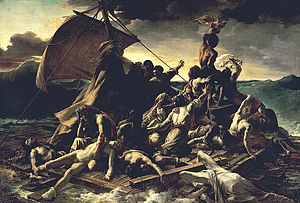 Théodore Géricault's Raft of the Medusa, circa 1820
Théodore Géricault's Raft of the Medusa, circa 1820 Further information: Art and politics
Further information: Art and politicsThéodore Géricault's Raft of the Medusa (c. 1820), was a social commentary on a current event, unprecedented at the time. Édouard Manet's Le Déjeuner sur l'Herbe (1863), was considered scandalous not because of the nude woman, but because she is seated next to men fully dressed in the clothing of the time, rather than in robes of the antique world. John Singer Sargent's Madame Pierre Gautreau (Madam X) (1884), caused a huge uproar over the reddish pink used to color the woman's ear lobe, considered far too suggestive and supposedly ruining the high-society model's reputation.
In the twentieth century, Pablo Picasso's Guernica (1937) used arresting cubist techniques and stark monochromatic oils, to depict the harrowing consequences of a contemporary bombing of a small, ancient Basque town. Leon Golub's Interrogation III (1981), depicts a female nude, hooded detainee strapped to a chair, her legs open to reveal her sexual organs, surrounded by two tormentors dressed in everyday clothing. Andres Serrano's Piss Christ (1989) is a photograph of a crucifix, sacred to the Christian religion and representing Christ's sacrifice and final suffering, submerged in a glass of the artist's own urine. The resulting uproar led to comments in the United States Senate about public funding of the arts.
Art theories
In the nineteenth century, artists were primarily concerned with ideas of truth and beauty. The aesthetic theorist John Ruskin, who championed what he saw as the naturalism of J. M. W. Turner, saw art's role as the communication by artifice of an essential truth that could only be found in nature.[27]
The definition and evaluation of art has become especially problematic since the 20th century. Richard Wollheim distinguishes three approaches: the Realist, whereby aesthetic quality is an absolute value independent of any human view; the Objectivist, whereby it is also an absolute value, but is dependent on general human experience; and the Relativist position, whereby it is not an absolute value, but depends on, and varies with, the human experience of different humans.[28]
The arrival of Modernism in the late nineteenth century lead to a radical break in the conception of the function of art,[29] and then again in the late twentieth century with the advent of postmodernism. Clement Greenberg's 1960 article "Modernist Painting" defines modern art as "the use of characteristic methods of a discipline to criticize the discipline itself".[30] Greenberg originally applied this idea to the Abstract Expressionist movement and used it as a way to understand and justify flat (non-illusionistic) abstract painting:
Realistic, naturalistic art had dissembled the medium, using art to conceal art; modernism used art to call attention to art. The limitations that constitute the medium of painting – the flat surface, the shape of the support, the properties of the pigment — were treated by the Old Masters as negative factors that could be acknowledged only implicitly or indirectly. Under Modernism these same limitations came to be regarded as positive factors, and were acknowledged openly.[30]After Greenberg, several important art theorists emerged, such as Michael Fried, T. J. Clark, Rosalind Krauss, Linda Nochlin and Griselda Pollock among others. Though only originally intended as a way of understanding a specific set of artists, Greenberg's definition of modern art is important to many of the ideas of art within the various art movements of the 20th century and early 21st century.
Pop artists like Andy Warhol became both noteworthy and influential through work including and possibly critiquing popular culture, as well as the art world. Artists of the 1980s, 1990s, and 2000s expanded this technique of self-criticism beyond high art to all cultural image-making, including fashion images, comics, billboards and pornography.
Classification disputes
Main article: Classificatory disputes about artDisputes as to whether or not to classify something as a work of art are referred to as classificatory disputes about art.
Classificatory disputes in the 20th century have included cubist and impressionist paintings, Duchamp's Fountain, the movies, superlative imitations of banknotes, conceptual art, and video games.[31]
Philosopher David Novitz has argued that disagreement about the definition of art are rarely the heart of the problem. Rather, "the passionate concerns and interests that humans vest in their social life" are "so much a part of all classificatory disputes about art" (Novitz, 1996). According to Novitz, classificatory disputes are more often disputes about societal values and where society is trying to go than they are about theory proper. For example, when the Daily Mail criticized Hirst's and Emin's work by arguing "For 1,000 years art has been one of our great civilising forces. Today, pickled sheep and soiled beds threaten to make barbarians of us all" they are not advancing a definition or theory about art, but questioning the value of Hirst's and Emin's work.[32] In 1998, Arthur Danto, suggested a thought experiment showing that "the status of an artifact as work of art results from the ideas a culture applies to it, rather than its inherent physical or perceptible qualities. Cultural interpretation (an art theory of some kind) is therefore constitutive of an object's arthood."[33][34]
Anti-art is a label for art that intentionally challenges the established parameters and values of art;[35] it is term associated with Dadaism and attributed to Marcel Duchamp just before World War I,[35] when he was making art from found objects.[35] One of these, Fountain (1917), an ordinary urinal, has achieved considerable prominence and influence on art.[35] Anti-art is a feature of work by Situationist International,[36] the lo-fi Mail art movement, and the Young British Artists,[35] though it is a form still rejected by the Stuckists,[35] who describe themselves as anti-anti-art.[37][38]
Art, class, and value
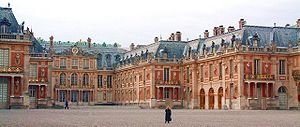 Versailles: Louis Le Vau opened up the interior court to create the expansive entrance cour d'honneur, later copied all over Europe.
Versailles: Louis Le Vau opened up the interior court to create the expansive entrance cour d'honneur, later copied all over Europe.
Art is sometimes perceived as belonging exclusively to higher social classes. In this context, art is seen as an upper-class activity associated with wealth, the ability to purchase art, and the leisure required to pursue or enjoy it. The Palace of Versailles and the Hermitage in St. Petersburg illustrate this view: such vast collections of art are the preserve of the rich, of governments and wealthy organizations.
Fine and expensive goods have been popular markers of status in many cultures, and they continue to be so today. There has been a cultural push in the other direction since at least 1793, when the Louvre, which had been a private palace of the Kings of France, was opened to the public as an art museum during the French Revolution. Most modern public museums and art education programs for children in schools can be traced back to this impulse to have art available to everyone. Museums in the United States tend to be gifts from the very rich to the masses (The Metropolitan Museum of Art in New York City, for example, was created by John Taylor Johnston, a railroad executive whose personal art collection seeded the museum.) But despite all this, at least one of the important functions of art in the 21st century remains as a marker of wealth and social status.
 Performance by Joseph Beuys, 1978: Everyone an artist — On the way to the libertarian form of the social organism
Performance by Joseph Beuys, 1978: Everyone an artist — On the way to the libertarian form of the social organism
There have been attempts by artists to create art that can not be bought by the wealthy as a status object. One of the prime original motivators of much of the art of the late 1960s and 1970s was to create art that could not be bought and sold. It is "necessary to present something more than mere objects"[39] said the major post war German artist Joseph Beuys. This time period saw the rise of such things as performance art, video art, and conceptual art. The idea was that if the artwork was a performance that would leave nothing behind, or was simply an idea, it could not be bought and sold. "Democratic precepts revolving around the idea that a work of art is a commodity impelled the aesthetic innovation which germinated in the mid-1960s and was reaped throughout the 1970s. Artists broadly identified under the heading of Conceptual art... substituting performance and publishing activities for engagement with both the material and materialistic concerns of painted or sculptural form... [have] endeavored to undermine the art object qua object."[40]
In the decades since, these ideas have been somewhat lost as the art market has learned to sell limited edition DVDs of video works,[41] invitations to exclusive performance art pieces, and the objects left over from conceptual pieces. Many of these performances create works that are only understood by the elite who have been educated as to why an idea or video or piece of apparent garbage may be considered art. The marker of status becomes understanding the work instead of necessarily owning it, and the artwork remains an upper-class activity. "With the widespread use of DVD recording technology in the early 2000s, artists, and the gallery system that derives its profits from the sale of artworks, gained an important means of controlling the sale of video and computer artworks in limited editions to collectors."[42]
See also
Notes
- ^ Gombrich, Ernst. (2005). "Press statement on The Story of Art". The Gombrich Archive. http://www.gombrich.co.uk/showdoc.php?id=68. Retrieved 2008-11-18.
- ^ Wollheim 1980, op. cit. Essay VI. pp. 231–39.
- ^ Richard Wollheim, Art and its objects, p.1, 2nd edn, 1980, Cambridge University Press, ISBN 0521297060
- ^ a b Jerrold Levinson, The Oxford Handbook of Aesthetics, Oxford university Press, 2003, p5. ISBN 0-1992-7945-4
- ^ Jerrold Levinson, The Oxford Handbook of Aesthetics, Oxford university Press, 2003, p16. ISBN 0-1992-7945-4
- ^ R.G. Collingwood's view, expressed in The Principles of Art, is considered in Wollheim, op. cit. 1980 pp 36–43
- ^ Martin Heidegger, "The Origin of the Work of Art", in Poetry, Language, Thought, (Harper Perenniel, 2001). See also Maurice Merleau-Ponty, "Cézanne's Doubt" in The Merleau-Ponty Aesthetics Reader, Galen Johnson and Michael Smith (eds), (Northwestern University Press, 1994) and John Russon, Bearing Witness to Epiphany, (State University of New York Press, 2009).
- ^ Elkins, James "Art History and Images That Are Not Art", The Art Bulletin, Vol. 47, No. 4 (Dec. 1995), with previous bibliography. "Non-Western images are not well described in terms of art, and neither are medieval paintings that were made in the absence of humanist ideas of artistic value". 553
- ^ The New Shorter Oxford English Dictionary. Oxford University Press, Oxford 1993, p. 120
- ^ Karl Robert Mandelkow, Bodo Morawe: Goethes Briefe. 2. edition. Vol. 1: Briefe der Jahre 1764-1786. Christian Wegner, Hamburg 1968, p. 487 (German)
- ^ David Novitz, "The Boundaries of Art", 1992
- ^ Radford, Tim. "World's Oldest Jewellery Found in Cave". Guardian Unlimited, April 16, 2004. Retrieved on January 18, 2008.
- ^ [1]
- ^ John Stothoff Badeau and John Richard Hayes, The Genius of Arab civilization: source of Renaissance. Taylor & Francis. 1983. p. 104
- ^ Adorno, Theodor W., Aesthetic Theory, (1970 in German)
- ^ Robertson, Jean and Craig McDaniel: Themes of Contemporary Art, Visual Art after 1980, page 4. Oxford University Press, 2005.
- ^ Breskin, Vladimir, Triad: Method for studying the core of the semiotic parity of language and art, Signs – International Journal of Semiotics 3, pp.1–28, 2010. ISSN: 1902-8822
- ^ Graham, Gordon (2005). Philosophy of the arts: an introduction to aesthetics. Taylor & Francis.
- ^ Aristotle. The Poetics, Republic
- ^ Aristotle. The Poetics, Republic. Note: Although speaking mostly of poetry here, the Ancient greeks often speak of the arts collectively. http://www.authorama.com/the-poetics-2.html
- ^ Einstein, Albert. The World as I See It. http://www.aip.org/history/einstein/essay.htm
- ^ Immanuel Kant, Critique of Aesthetic Judgement (1790).
- ^ Silvia Tomaskova, "Places of Art: Art and Archaeology in Context": (1997)
- ^ Steve Mithen. The Prehistory of the Mind: The Cognitive Origins of Art, Religion and Science. 1999
- ^ André Breton, Surrealist Manifesto (1924)
- ^ Roland Barthes, Mythologies
- ^ "go to nature in all singleness of heart, rejecting nothing and selecting nothing, and scorning nothing, believing all things are right and good, and rejoicing always in the truth." Ruskin, John. Modern Painters, Volume I, 1843. London: Smith, Elder and Co.
- ^ Wollheim 1980, Essay VI. pp. 231–39.
- ^ Griselda Pollock, Differencing the Canon. Routledge, London & N.Y.,1999. ISBN 0-415-06700-6
- ^ a b Modern Art and Modernism: A Critical Anthology. ed. Francis Frascina and Charles Harrison, 1982.
- ^ Deborah Solomon, "2003: the 3rd Annual Year in Ideas: Video Game Art", New York Times, Magazine Section, December 14, 2003
- ^ Painter, Colin. "Contemporary Art and the Home". Berg Publishers, 2002. p. 12. ISBN 1-8597-3661-0
- ^ Dutton, Denis Tribal Art in Encyclopedia of Aesthetics, edited by Michael Kelly (New York: Oxford University Press, 1998).
- ^ Danto, Arthur. "Artifact and Art." In Art/Artifact, edited by Susan Vogel. New York, 1988.
- ^ a b c d e f "Glossary: Anti-art", Tate. Retrieved 23 January 2010.
- ^ Schneider, Caroline. "Asger Jorn", Artforum, 1 September 2001. Retrieved from encyclopedia.com, 24 January 2010.
- ^ Ferguson, Euan. "In bed with Tracey, Sarah ... and Ron", The Observer, 20 April 2003. Retrieved on 2 May 2009.
- ^ "Stuck on the Turner Prize", artnet, 27 October 2000. Retrieved on 2 May 2009.
- ^ Sharp, Willoughby (December 1969). "An Interview with Joseph Beuys". ArtForum 8 (4): 45.
- ^ Rorimer, Anne: New Art in the 60s and 70s Redefining Reality, page 35. Thames and Hudson, 2001.
- ^ Fineman, Mia (2007-03-21). "YouTube for ArtistsThe best places to find video art online.". Slate. http://www.slate.com/id/2162382/. Retrieved 2007-08-03.
- ^ Robertson, Jean and Craig McDaniel: Themes of Contemporary Art, Visual Art after 1980, page 16. Oxford University Press, 2005.
Bibliography
- Arthur Danto, The Abuse of Beauty: Aesthetics and the Concept of Art. 2003
- Dana Arnold and Margaret Iverson (eds.) Art and Thought. Oxford: Basil Blackwell, 2003.
- Michael Ann Holly and Keith Moxey (eds.) Art History and Visual Studies. Yale University Press, 2002.
- John Whitehead. Grasping for the Wind. 2001
- Noel Carroll, Theories of Art Today. 2000
- Evelyn Hatcher, ed. Art as Culture: An Introduction to the Anthropology of Art. 1999
- Catherine de Zegher (ed.). Inside the Visible. MIT Press, 1996.
- Nina, Felshin, ed. But is it Art? 1995
- Stephen Davies, Definitions of Art. 1991
- Oscar Wilde, "Intentions".
- Jean Robertson and Craig McDaniel, "Themes of Contemporary Art, Visual Art after 1980." 2005
Further reading
- Augros, Robert M., Stanciu, George N., The New Story of Science: mind and the universe, Lake Bluff, Ill.: Regnery Gateway, c1984. ISBN 0895268337 (this book has significant material on Art and Science)
- Richard Wollheim, Art and its Objects
- Carl Jung, Man and His Symbols
- Benedetto Croce, Aesthetic as Science of Expression and General Linguistic, 1902
- Władysław Tatarkiewicz, A History of Six Ideas: an Essay in Aesthetics, translated from the Polish by Christopher Kasparek, The Hague, Martinus Nijhoff, 1980.
- Leo Tolstoy, What Is Art?, 1897
- Kleiner, Gardner, Mamiya and Tansey (2004). Art Through the Ages, Twelfth Edition (2 volumes). Wadsworth. ISBN 0-534-64095-8 (vol 1) and ISBN 0-534-64091-5 (vol 2).
- Kristine Stiles and Peter Selz, eds., Theories and Documents of Contemporary Art. Berkeley: University of California Press, 1996.
External links
- Art and Play from the Dictionary of the History of ideas
- In-depth directory of art
- Art and Artist Files in the Smithsonian Libraries Collection (2005) Smithsonian Digital Libraries
- Visual Arts Data Service (VADS) – online collections from UK museums, galleries, universities
- RevolutionArt – Art magazines with worldwide exhibitions, callings and competitions
- The Definition of Art entry by Thomas Adajian in the Stanford Encyclopedia of Philosophy
Categories:
Wikimedia Foundation. 2010.




